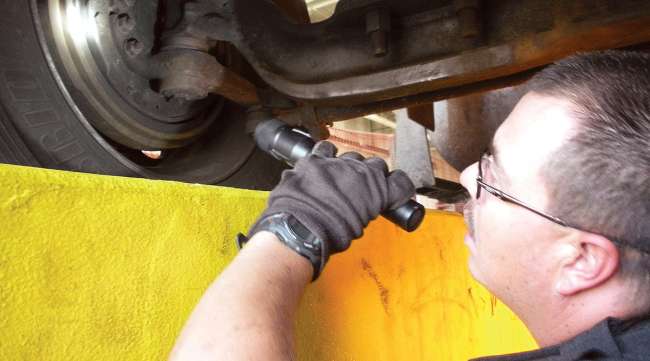Senior Reporter
Inspectors Place 13.3% of CMVs Out of Service During Brake Safety Week

[Stay on top of transportation news: Get TTNews in your inbox.]
Commercial motor vehicle inspectors in North America conducted 38,117 inspections Aug. 21-27 during Brake Safety Week, placing 13.3% of vehicles out of service for brake-related violations.
Inspectors in the United States, Canada and Mexico also identified and documented 6,305 brake hose/tube chafing violations, a common brake-related violation that was the focus of this year’s special brake safety enforcement effort, according to an announcement Nov. 15 by the Commercial Vehicle Safety Alliance.
The brake hose chafing violations were in four categories, with varying levels of chafing severity.
Inspectors compiled and then submitted brake-related data to the alliance for compilation, analysis and release.
Last week MCCD Officers around the state participated in @CVSA’s Brake Safety Week. Officers inspected 1,117 commercial motor vehicles and placed 141 out of service for brake-related violations. #gamccd #cvsa #fmcsa pic.twitter.com/zudf8yFxqJ — Georgia Department of Public Safety (@ga_dps) August 31, 2022
Brake Safety Week was part of CVSA’s Operation Airbrake program, in partnership with the U.S. Federal Motor Carrier Safety Administration, the Canadian Council of Motor Transport Administrators, and Mexico’s Ministry of Communications and Transportation.
The goal was to reduce the number of crashes caused by faulty braking systems on commercial motor vehicles by conducting roadside inspections and educating drivers, mechanics, owner-operators and others on the importance of proper brake inspection, maintenance and operation.
During @CVSA International Brake Safety Week, #NDHP Troopers and inspectors are conducting level 1 inspections to identify brake-related defects. Pre and Post trip inspections by professional drivers and safe CMVs result in #SafeTravel for everyone on our roads. pic.twitter.com/AG0BYdXKLF — North Dakota Highway Patrol (@NDHighwayPatrol) August 24, 2022
CVSA officials have said that properly functioning brakes may mean the difference between a catastrophic collision or the ability to avoid a crash.
The special operation was certainly not a secret. CVSA announced this year’s Brake Safety Week dates in June. The Alliance announced the dates in advance to remind drivers and motor carriers about the importance of proper brake maintenance and to encourage proactive vehicle maintenance before the special enforcement effort.
Next year’s Brake Safety Week is scheduled for Aug. 20-26.
Brake Safety Week in underway. From Aug. 21-27, CMV inspectors are conducting their usual North American Standard Level I and IV Inspections; however, in addition, they're documenting brake-related out-of-service and brake hose/tube chafing violations. https://t.co/iuZw3BdgYv pic.twitter.com/ayfSb5yCya — CVSA (@CVSA) August 23, 2022
During Brake Safety Week, inspectors primarily conducted the North American Standard Level I or Level V Inspection. Both levels include thorough examination of brake systems and components. Inspectors specifically looked for missing, non-functioning, loose, cracked or broken parts, such as spider castings, return springs, brake drums or rotors, brake shoes, linings or pads and slack adjusters.
They also inspected for contaminated linings or pads, non-manufactured holes in spring brake housings, S-cam flip-over, and audible air leaks. They also checked for mismatched brake chambers on an axle, security of air reservoirs, condition of hoses and lines, air pressure in the system, the breakaway device, tractor protection system, pushrod travel and brake-system warning devices.
Fifty-three Canadian and U.S. jurisdictions, and Mexico’s Ministry of Communications and Transportation participated in this year’s Brake Safety Week, which was a voluntary brake-safety inspection and special enforcement initiative.
It's #BrakeSafetyWeek, Aug. 21-27. Properly functioning brake systems are crucial to safe CMV operation. Improperly installed or poorly maintained brake systems can reduce the braking capacity and increase stopping distances for trucks and motorcoaches. https://t.co/iuZw3BdgYv pic.twitter.com/aqokzDfuOd — CVSA (@CVSA) August 22, 2022
Broken out by country, inspectors in Canada inspected 1,975 commercial motor vehicles and placed 351 (17.8%) out of service for brake-related violations. In Mexico, 1,740 commercial motor vehicles were inspected. Forty-four (2.5%) were placed out of service. In the United States, of the 34,402 commercial motor vehicles inspected, 4,664 (13.6%) were placed out of service.
In addition, 11 jurisdictions with performance-based brake testers assessed the braking performance of 392 commercial motor vehicles during Brake Safety Week. Twenty-nine commercial motor vehicles failed their performance-based brake test (PBBT) — a 7% out-of-service rate. PBBTs, based on mechanical or electronic decelerometers, assess the overall vehicle braking capability through a stopping performance test in which deceleration and/or stopping distance is obtained, independent of brake type or application method.
Vehicles that did not have any vehicle and driver out-of-service violations during a Level I or Level V Inspection may have received a CVSA decal, which is a visual indicator — valid for three months — to inspectors that the vehicle was recently inspected and had no critical vehicle inspection item violations.
Last year, 12% of the 35,764 commercial motor vehicles inspected were placed out of service during Brake Safety Week due to critical brake-related violations.
Want more news? Listen to today's daily briefing below or go here for more info:




